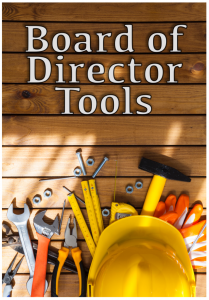Every nonprofit organization and school has a Board of Directors that is meant to help govern the organization. There are many companies, books, and webinars that solely focus on supporting Boards of Directors. Over the years, we have found and developed some key tools that are easy to apply to help organizations and their Boards govern more effectively.
 While some of these Board tools might seem standard, we still find that these are missing and/or have not been well developed. We could write a blog post about each of these tools (and maybe we will!). This is a quick overview of the value and purpose of each tool to help your organization think about how you might integrate them into your Board of Directors.
While some of these Board tools might seem standard, we still find that these are missing and/or have not been well developed. We could write a blog post about each of these tools (and maybe we will!). This is a quick overview of the value and purpose of each tool to help your organization think about how you might integrate them into your Board of Directors.
8 Tools to Strengthen Your Board of Directors
- Bylaws: This is a legal document and also a roadmap for actions that the organization can take. While there are plenty of bylaws templates online, your organization should customize your bylaws. Some basic items to include in bylaws are: number of board members, how board members are selected, board meetings, committees, voting procedures, conflicts of interest, etc. We recommend that organizations annually review their bylaws and make sure that they are clear and provide good instruction to guide the Board of Directors.
- Board Manual or Handbook: The Board handbook is the “toolbox” for Board members that provides more detail than the bylaws. This is a great resource to review during new Board member orientation. Some of the key elements that we look for and include in Board Handbooks are: Organization Overview, Contact Information, Board Meetings, Finances and Fundraising, Governance, Committees, Board Policies, and Board Resources.
- Board Member Job Description: The last thing that an Executive Director or Board President wants to hear from a Board member is, “I didn’t know I was joining the Board to do ______.” One of the most prominent issues that we come across in working with Board of Directors is a lack of clear expectations for the Board of Directors. A Board Member Job Description is exactly as it sounds and similar to an employee job description. It clearly articulates what is expected of the Board member, such as meeting attendance, committee involvement, other organization involvement (e.g, attendance at certain events), a “give or get” policy (related to fundraising), and member terms. This information should all be communicated during the recruitment process, so that when the Board member is signing the form there are no surprises and everyone is in agreement about expectations.
- Board Self-Assessment: In healthy organizations, there are ongoing performance reviews and assessments to check-in on how well the organization and its employees are functioning. The Board Self-Assessment is a good exercise for the Board to reflect on how well the Board is functioning regarding some key best practices. This could be a good practice to complete with a 3-year strategic plan. We have developed a 3-page Board self-assessment tool, and there are many online.
- 1:1 Individual Board Member Check-In: One strategy to engage current Board members is to schedule individual annual meetings with each Board member and the Executive Director and Board President/ Vice President. These individual check-in meetings provide a great opportunity to review the expectations of being a Board member, celebrate the successes and engagement of the last year, and follow up on any concerns. It is also a great time for the Board member to affirm their commitment for the coming year, such as financial pledge, leadership and/or committee roles, and any connections to make.
- Board Meeting Calendar and Key Decisions Meeting Calendar: This is a “two-fer”. Yes, it may seem simple to state that a Board tool is a meeting calendar/ schedule, but you would be surprised by how many organizations do not have a clear meeting schedule and then struggle with attendance. We suggest sending out the Board meeting calendar for the year to all Board members and including any additional important dates (e.g., annual member meeting, required fundraising event, etc.). In addition, in order to help drive strategic decisions at the Board meeting we suggest developing a “key decision meeting calendar.” Every organization has some key decisions that the Board will need to vote on and/or participate in, so it is helpful to put those on the calendar, such as annual budget review, program evaluation reports, and strategic plans (planning, check-in, or updates).
- Board Member Recruitment Process: While the bylaws should outline at a high-level the process to approve new Board members a more detailed recruitment plan is helpful to standardize the process. We often work with many organizations who struggle with small Boards of Directors and are wanting to recruit more Board members but lack a clear understanding of the type of Board member that would be a good fit and a process for recruitment. We have developed several Board recruitment tools: a board composition assessment (what are your current “assets” and “strengths” on the Board and then your “gaps”); a nomination form that Board members can submit when they want to recommend a candidate; a new member application to gather some key information from prospects; and interview questions that Board members use when meeting with a prospective member.
- Communication Flowchart: The last thing that an organization wants is to have one of their board members approached by a volunteer or staff member making a request, and the board member not know the procedure for how certain decisions are made. A communication flowchart explains how decisions are made within the organization and the role of the Board of Directors and its Committees.
How well is your Board functioning? Would any of these tools help improve the effectiveness of your Board? Transform Consulting Group would love to work with your organization to identify opportunities to strengthen your Board and ultimately the impact of your organization. Contact us today for a free consultation.

